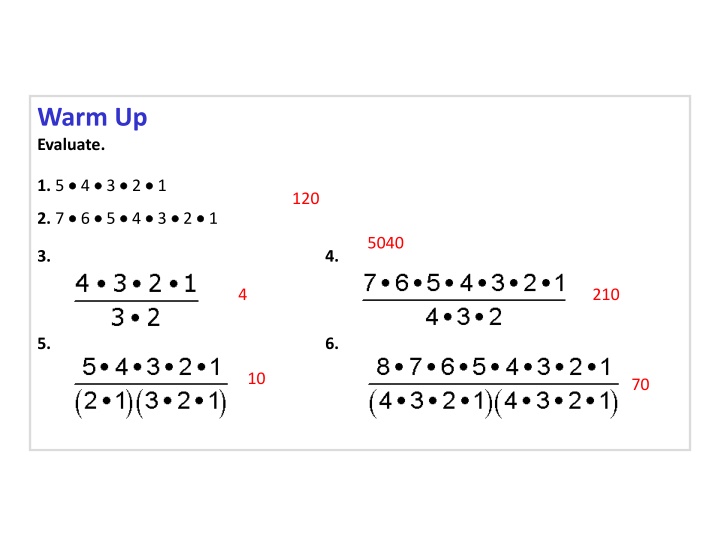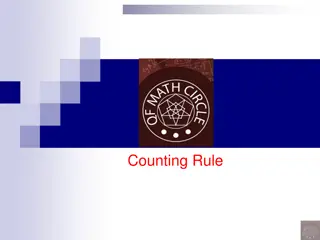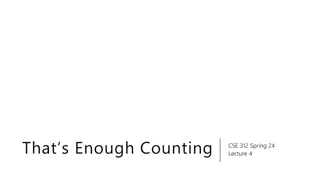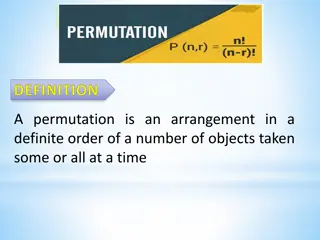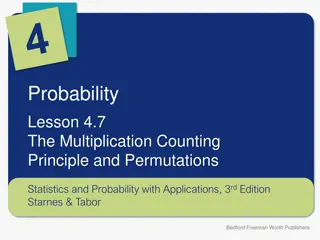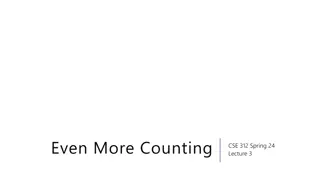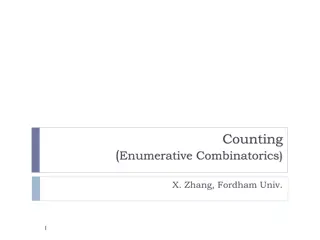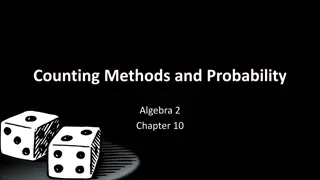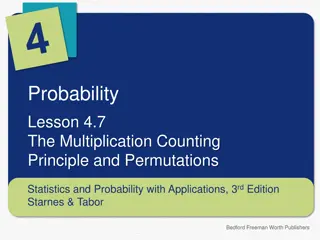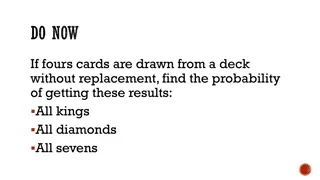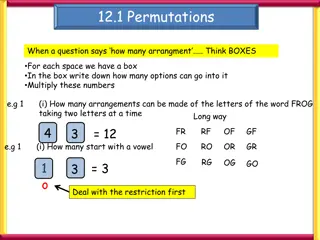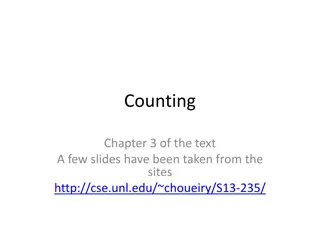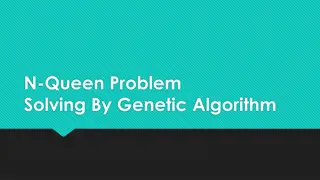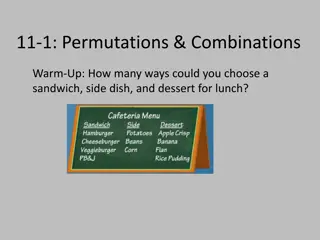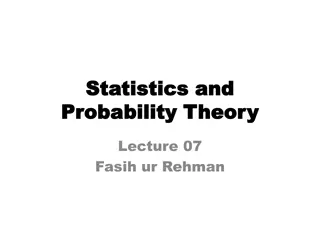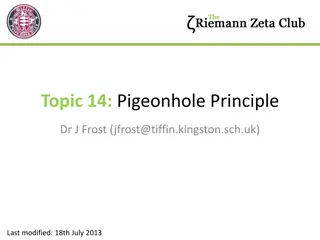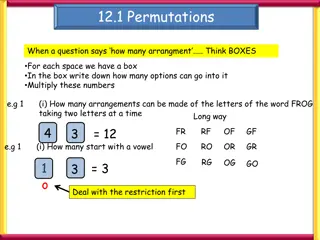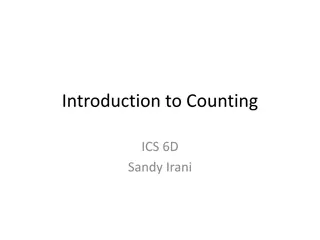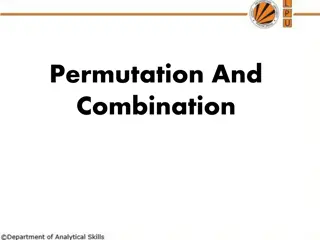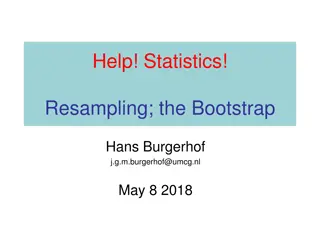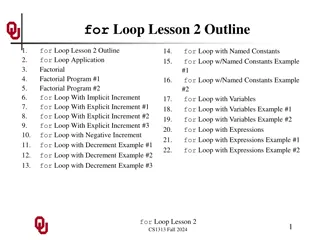Fundamental Counting Principle and Permutations in Mathematics
Explore the concept of the Fundamental Counting Principle through examples involving creating yogurt parfaits and generating passwords. Dive into permutations with scenarios like selecting student government officials. Visual aids and step-by-step explanations bring clarity to these mathematical concepts.
Download Presentation

Please find below an Image/Link to download the presentation.
The content on the website is provided AS IS for your information and personal use only. It may not be sold, licensed, or shared on other websites without obtaining consent from the author.If you encounter any issues during the download, it is possible that the publisher has removed the file from their server.
You are allowed to download the files provided on this website for personal or commercial use, subject to the condition that they are used lawfully. All files are the property of their respective owners.
The content on the website is provided AS IS for your information and personal use only. It may not be sold, licensed, or shared on other websites without obtaining consent from the author.
E N D
Presentation Transcript
Warm Up Evaluate. 1. 5 4 3 2 1 120 2. 7 6 5 4 3 2 1 5040 3. 4. 4 210 6. 5. 10 70
Example 1A: Using the Fundamental Counting Principle To make a yogurt parfait, you choose one flavor of yogurt, one fruit topping, and one nut topping. How many parfait choices are there? Yogurt Parfait (choose 1 of each) Fruit Peaches Strawberries Bananas Raspberries Blueberries Flavor Plain Vanilla Nuts Almonds Peanuts Walnuts
Example 1A Continued number of flavors number of fruits number of nuts number of choices equals times times 2 5 3 = 30 There are 30 parfait choices.
Example 1b A password is 4 letters followed by 1 digit. Uppercase letters (A) and lowercase letters (a) may be used and are considered different. How many passwords are possible? Since both upper and lower case letters can be used, there are 52 possible letter choices. letter letter letter letter number 52 52 52 52 10 = 73,116,160 There are 73,116,160 possible passwords.
Example 2: Paint Colors A paint manufacturer wishes to manufacture several different paints. The categories include Color: red, blue, white, black, green, brown, yellow Type: latex, oil Texture: flat, semi gloss, high gloss Use: outdoor, indoor How many different kinds of paint can be made if you can select one color, one type, one texture, and one use? ( colors types textures uses 7 2 )( )( )( ) # of # of # of # of 3 2 84 different kinds of paint 6 Bluman, Chapter 4
A permutation is a selection of a group of objects in which order is important.
Example 3A: Finding Permutations How many ways can a student government select a president, vice president, secretary, and treasurer from a group of 6 people? This is the equivalent of selecting and arranging 4 items from 6. Substitute 6 for n and 4 for r in Divide out common factors. = 6 5 4 3 = 360 There are 360 ways to select the 4 people.
Example 3B: Finding Permutations How many ways can a stylist arrange 5 of 8 vases from left to right in a store display? Divide out common factors. = 8 7 6 5 4 = 6720 There are 6720 ways that the vases can be arranged.
Example 4: Business Locations Suppose a business owner has a choice of 5 locations in which to establish her business. She decides to rank each location according to certain criteria, such as price of the store and parking facilities. How many different ways can she rank the 5 locations? ( choice choice choice choice choice 5 4 3 )( )( )( )( ) first second third fourth fifth 2 1 120 different ways to rank the locations Using factorials, 5! = 120. Using permutations, 5P5 = 120. 11 Bluman, Chapter 4
Example 5: Television News Stories A television news director wishes to use 3 news stories on an evening show. One story will be the lead story, one will be the second story, and the last will be a closing story. If the director has a total of 8 stories to choose from, how many possible ways can the program be set up? Since there is a lead, second, and closing story, we know that order matters. We will use permutations. 8! 336 5! 8 3 P = = P = = or 8 7 6 336 8 3 3 12 Bluman, Chapter 4
A combination is a grouping of items in which order does not matter. There are generally fewer ways to select items when order does not matter.
When deciding whether to use permutations or combinations, first decide whether order is important. Use a permutation if order matters and a combination if order does not matter.
Example 6: Application There are 12 different-colored cubes in a bag. How many ways can Randall draw a set of 4 cubes from the bag? Step 1 Determine whether the problem represents a permutation of combination. The order does not matter. The cubes may be drawn in any order. It is a combination.
Example 6 Continued Step 2 Use the formula for combinations. n = 12 and r = 4 Divide out common factors. 5 = 495 There are 495 ways to draw 4 cubes from 12.
Example 7: Newspaper Editing A newspaper editor has received 8 books to review. He decides that he can use 3 reviews in his newspaper. How many different ways can these 3 reviews be selected? The placement in the newspaper is not mentioned, so order does not matter. We will use combinations. 8! 5!3! ( ) C = = = 8!/ 5!3! 56 8 3 P 8 7 6 3 2 C = = = = or 56 8 3 or 56 C 8 3 8 3 3! 17 Bluman, Chapter 4
Example 8: Combination Locks A combination lock consists of the 26 letters of the alphabet. If a 3-letter combination is needed, find the probability that the combination will consist of the letters ABC in that order. The same letter can be used more than once. (Note: A combination lock is really a permutation lock.) There are 26 26 26 = 17,576 possible combinations. The letters ABC in order create one combination. 1 ( ) = ABC P 17,576 18 Bluman, Chapter 4
Example 9: Committee Selection A store has 6 TV Graphic magazines and 8 Newstime magazines on the counter. If two customers purchased a magazine, find the probability that one of each magazine was purchased. TV Graphic: One magazine of the 6 magazines Newstime: One magazine of the 8 magazines Total: Two magazines of the 14 magazines 6 8 91 48 91 C C = = 6 1 8 C 1 14 2 19 Bluman, Chapter 4
Homework Pg. 220 # 7, 11, 13, 27, 33, 35
